
Bill Britton is a freelance writer for John Hopkins University and a contributing editor for Vero Communiqué.
The Tragedy of the Commons
“The tragedy of the commons [shared resources]” is an economic theory where individual users acting independently according to their own self-interest work, collectively, against the common good by abusing those resources (see “The Tragedy of the Commons,” G. Harden. Science: 12.13.1968).

Examples of this abuse abound, from the general depletion of Earth’s fisheries, to the Cuyahoga River fire of 1969, and, more recently, to the ongoing Flint, Michigan water crisis. The response to each of these crises has been the call for regulations to avert such continuing tragedies, a response which runs counter to free-market (unregulated) advocates from, mainly, the Republican Party and, in general, from the business community as a whole.
But the potential for abuse is not confined to environmental or safety issues alone. The commons can be said to embrace the overall security of the individual citizen within the general population. Obvious mechanisms to safeguard that security include the armed forces and the local police. Less understood, and often labeled “restrictive,” are the regulatory mechanisms put in place to protect the environment or the nation’s economic wellbeing within the greater world community.
Regulations as a “Burden”
Environmental regulations have been defined by some free marketers as a “burden” on business and have constrained economic growth. Extremist libertarians have called for the elimination of all regulations; in other words, allow the marketplace the freedom to be self-regulating under the assumption that reduced regulations will ensure both economic expansion and the public interest; “reduced,” under this regimen, usually means minimal or none. This thinking is a distortion of Adam Smith’s “invisible hand.”
Not considered under a regulation-free economic system are negative “externalities”: side effects of human activities that affect other parties directly or indirectly (through environmental degradation) without this effect being reflected in the cost of the goods or services involved, such as fossil-fuel emissions or uncaptured industrial wastes released into the environment.
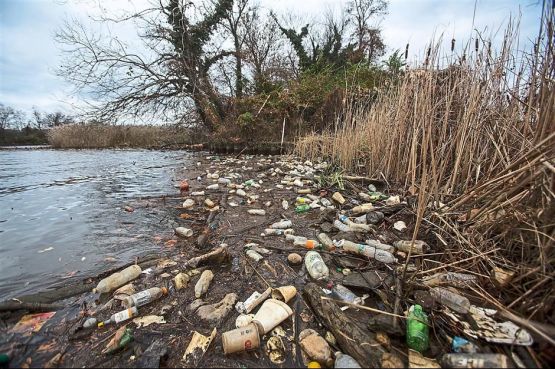
Environmental Degradation: Plastic bottles and other debris float on the banks of the Anacosta River in Washington, DC. (Star2.com)
In 2016, a reasonable regulation was put in pace to limit the dumping of coal mine tailings into thousands of miles of streams across coal country. President Trump repealed this rule because he claimed this restrained job growth in, mainly, Appalachia.
But given the fact that it takes a mere handful of miners to extract the coal from a single mountaintop in, say, Kentucky, the number of jobs added since the inauguration has amounted to only 600, not the 40,000 claimed by Trump’s EPA chief Scott Pruitt (see http://www.snl.com/web/client?auth=inherit#news/article?id=40679845&cdid=A-40679845-10284). A cynic might say that Trump was trolling for campaign donations from coal-mining corporations, not jobs creation.
The Crisis around the Corner
Of all the externalities assaulting our planet, fossil-fuel emissions pose the greatest threat. In recognition of this, almost 200 nations have signed on to the Paris Climate Accord.
The United States joined Nicaragua and Syria (and possibly Turkey) in rejecting the agreement whose objective is to keep global temperatures from rising more than 2°C.
Exceeding this threshold could result in runaway warming and place Earth’s inhabitants at risk of extinction. Trump’s justification for his decision is that it will “save” American jobs. Of course, that decision will likely cede leadership in the manufacture and development of alternative energy products to China and Germany in particular, and to the Far East and Europe in general.
Similarly, negating the Obama era’s Clean Power Plan will remove restrictions on carbon emissions, even though the scientific community is virtually unanimous in naming human consumption of fossil fuels as the cause of global warming and sea rise, which Trump calls a “hoax.”
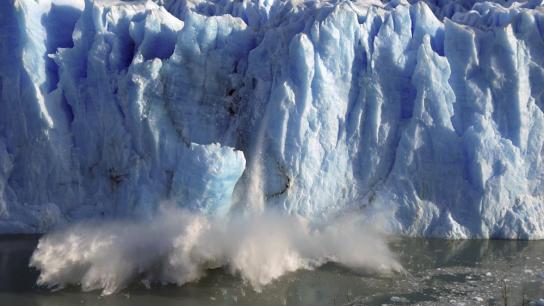
Climate Change: Foreign Affairs
In the not-too-distant future, Glacier National Park will need a new name, polar bears will need a new home, and cities like Miami and Houston will need to relocate their beachfront and docks, along with their downtown economic hubs. But the average citizen doesn’t necessarily appreciate changes amounting to a few centimeters sea rise per year or a few degrees per decade that they experience in their immediate surroundings. Despite this, the majority of Americans now believe global warming is real.
The Stacked Deck
In response to the economic catastrophe of the Great Depression, President Roosevelt and Congress passed the Glass-Steagall Act, a far-reaching measure that established federal deposit insurance as well as the separation of investment banking from deposit, or commercial, banking. Over the years, this “wall” between the two has been eliminated, while opportunities for financial abuses have expanded; concomitantly, as investment banks transitioned to becoming corporations, their liability was much reduced.
In 2008, the risks associated with subprime mortgage-backed securities came to a head with the near-collapse of the financial system. Future breakdowns are virtually inevitable, as the money gurus on Wall Street find end-arounds to whatever regulatory schema might be emplaced. Of course, free marketers blamed the debacle on irresponsible borrowers, not on the banks whose relaxed lending metrics nurtured irresponsibility.
The notion of “too big to fail” almost guarantees future collapses, since the potential returns on high-risk financial instruments is a no-lose proposition, at least for their creators if not for those at the bottom of the pecking order, typically the small investor or mortgagee. Despite paying $5 billion in penalties for defrauding investors in the period leading up to the 2008 crisis, Goldman Sachs is now riding high with obscene bonus pay-outs and a future made secure by “too big to fail.”
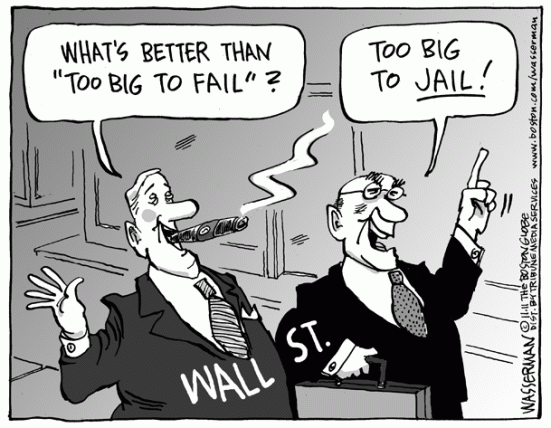
Besides corporations and their officers and stockholders having limited liability, corporations also enjoy the privilege of “personhood,” much expanded by the Citizens United case, which, in effect, removed any constraints on corporate campaign contributions. To claim that this Supreme Court ruling enhances the public good is delusional at best.
Wage Stagnation and the Job Market
Without a doubt, the economic wellbeing of the middle class soared during and after World War II. The manufacturing base of both allies and enemies was partly or totally destroyed. The United States, with the benefit of geographic isolation from direct conflict, escaped largely unscathed except for war deaths numbering 420 thousand. By contrast, the Soviet Union saw 25 million of its soldiers and civilians killed.
U.S. factories made a swift transition from a wartime to a peacetime economy, making cars instead of tanks, and cooking pots instead of army helmets. But a funny thing happened on the way to prosperity.
With help from the United States, the economies of Japan and Germany, especially, recovered rapidly and began producing high-quality manufactured goods. By the 1970s, U.S. car makers began to see their dominance wither in the face of superior engineering and design. At the same time, assembly lines closed in today’s “rust belt,” while their offshore counterparts opened in the union-free south.
President Trump has promised to make America great again by revitalizing the manufacturing sector. He began this effort by leaning on a few manufacturers that had planned on moving some production to Mexico or elsewhere. With great fanfare, Trump announce that Carrier would keep a manufacturing force of 1,100 in Indiana and receive $7 million in tax credits to increase that work force. Recently, Carrier announced that only 800 employees would be kept and a promised $16 million in new investment would go towards automation. Job creation indeed.
And that is the dilemma facing the American worker today: automation does not need maternity leave, vacation days, or health plans, among other employee overhead items.
When I did product forecasting in business, I sat down with an array of inputs from sales and production and made guesstimates of next year’s requirements and produced an Excel-generated spreadsheet 50 columns wide and 400 lines long.
Before I came on the scene, six people would spend a week doing this using pencils on huge paper accounting spreadsheets. Once I set it up on a PC, forecasts could be done in a few hours by one person. Today, I’m sure that one person has been eliminated in a fully integrated office system that uses algorithms, not guestimates, as primary inputs.
So, whether you are on a factory floor or in a back office, automation is breathing down your neck. The solution proposed by Silicon Valley gurus is to train or retrain workers to fill jobs in high tech. Good intentions aside, not all workers have the inclination or the basic educational skills to move into disciplines that involve more than repetitive tasks or structured routine. Even Wall Street is not immune to employment concerns, and a recent WSJ article offered up the sobering assessment that the financial sector could become the new Rust Belt (see https://hbr.org/2016/12/wall-street-jobs-wont-be-spared-from-automation).
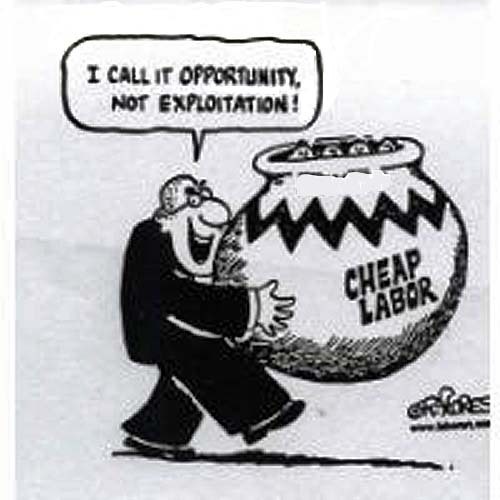
Wage explotación
As much as the President promises to bring jobs back to America, those promises are a pipedream. Any reclaimed start-ups will likely be fully automated enterprises using robots made in Japan, China, or Germany, with perhaps a few made in the United States. Hands-on manufacturing will become unceasingly redundant. Even the fast-food industry is looking toward automation, from order taking to food preparation.
Of course, the transfer of wealth to the top 1 percent (more accurately, 5 percent) continues unabated. Between 1978 and 2016, CEO pay rose by 937 percent. By contrast, the typical worker saw an 11 percent increase over the same period. The cozy relationship between corporate boards of directors and CEOs ensures the continuation of this disparity (see https://www.commondreams.org/news/2017/07/20/worker-wages-flat-1978-ceo-pay-has-soared-outrageous-937).
In addition, President Reagan’s “trickle-down economics” reigns supreme in conservative thinking: i.e., by reducing taxes on the wealthiest Americans and on corporations, business will have more dollars for investing in plants and equipment, thus expanding the incomes of the working class. The reality is that stockholders and corporate officers are the primary beneficiaries, not workers–trickle up, so to speak.
The Healthcare Debacle
Of all the advanced nations in the world, the United States is the only one without universal healthcare. In these countries, healthcare is considered a right, an aspect of the common good. In other words, by improving the health of the citizenry, the overall wellbeing of society is enhanced. The United States excels in the development of medical equipment and in the training of healthcare professionals. Where it falls short is in access and reasonable cost for much of the domestic population.
The Affordable Care Act (“Obamacare”) attempted to remedy this, but its shortcomings opened it up to attacks from Conservatives whose poorly conceived replacement attempts have thus far failed. During his campaign, Trump promised “cheaper and better” healthcare for all Americans, a promise that turned out to be vacuous to say the least.
Gerald Friedman, a professor of economics at the University of Massachusetts, says a nonprofit single-payer system based on the principles of the Expanded and Improved Medicare for All Act, H.R. 676, introduced by Rep. John Conyers Jr., and co-sponsored by 45 other lawmakers, would have saved an estimated $592 billion in 2014. (By comparison, the F-35 fighter aircraft boondoggle is projected to cost $507 billion, and rising.)
Friedman said the plan would be funded by maintaining current federal revenues for health care and imposing new, modest tax increases on very high income earners, by a small increase in payroll taxes on employers, who would no longer pay health insurance premiums, and by a new, small tax on stock and bond transactions. “Such a financing scheme would vastly simplify how the nation pays for care, restore free choice of physician, guarantee all necessary medical care, improve patient health and, because it would be financed by a program of progressive taxation, result in 95 percent of all U.S. households saving money,” Friedman said.
Friedman’s findings are consistent with other research showing large savings from a single-payer plan. Single-payer fiscal studies by other economists, such as Kenneth E. Thorpe (2005), have arrived at similar conclusions, as have studies conducted by the Congressional Budget Office and the General Accountability Office (see https://www.healthcare-now.org/blog/medicare-for-all-would-cover-everyone-save-billions-in-first-year/).

The Depletion of Humanity’s Support System
Estimates indicate that chromium, molybdenum, tungsten, nickel, platinum-palladium, copper, zinc, cadmium, titanium, uranium, and tin will soon face peak production followed by declines within this century (see https://www.theguardian.com/environment/earth-insight/2014/jun/04/mineral-resource-fossil-fuel-depletion-terraform-earth-collapse-civilisation).
All mineral resources are finite, including oil, natural gas, and coal, the main drivers of the Industrial Revolution, and they will continue to represent the undercarriage of the world economy for years to come.
A most alarming trend in mineral depletion concerns phosphate, which is critical to fertilize soil and sustain agriculture. While phosphate reserves are large, economic factors mean only a small percentage of it can be easily mined.
Once used as fertilizer, phosphate cannot be recovered. Crop yields on 40 percent of the world’s arable land is already limited by economical phosphorus availability. Those mounds of phosphate tailings you see running down Florida’s spine represent the last gasps of the Mosaic mining company’s operation in Florida.
Beyond the criticality of phosphate for agriculture, two other ingredients are vital to support increasing world demand for food: topsoil and water. Both are under pressure and neither resource can be rejuvenated except by the passage of tens of thousands or millions of years.
Since the beginning of the Industrial Revolution, half the World’s topsoil has been lost due to poor management, overuse, and erosion. What remains has been partially or totally degraded, its natural components reduced or altered by the accumulation of harmful salts from groundwater irrigation. Attempts to offset this loss, and thus increase farmland acreage, include deforestation and the extension of cropland into areas with limited rainfall using water from ancient aquifers. The Ogallala aquifer, running from north Texas to Nebraska, is a prime example and is being drawn down at an alarming rate.
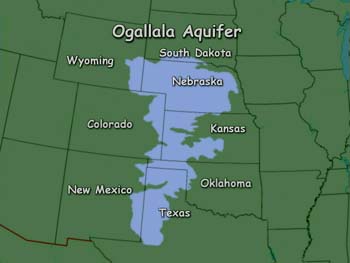
Economic Growth as a Panacea for What Ails America and the World
For growth advocates, an annual growth rate of 5 percent is the “holy grail,” one that will ensure America’s economic wellbeing. The last time that rate was achieved was in 1998 (see http://www.multpl.com/us-real-gdp-growth-rate/table/by-year), and since the 2008 contraction, it has not exceeded 3 percent. In response, the new administration has embarked on a crusade of deregulation and privatization, the free-market mantra.
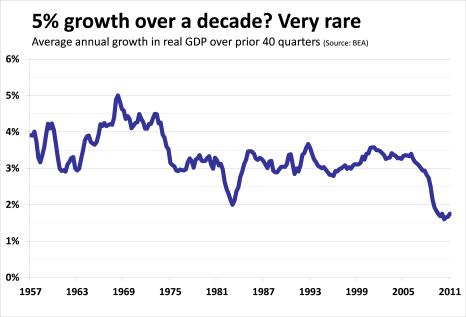
Yes, excessive regulation, any regulation, can inhibit economic growth. And, yes, the recent lifting of restrictions on coal-mine tailings being allowed to run off into Appalachian streams will reduce the overhead burden on the mining industry, but at what cost to the environment?
What all stakeholders in the “human experiment” ignore is the sustainability of growth itself, whether in terms of population or goods produced. By 2050, there will be 9.4 billion people alive on the planet, barring a war- or disease-induced catastrophe, a 25 percent increase from 2017’s 7.5 billion. (By 2100, that number could stand at 11.2 billion; see https://ourworldindata.org/world-population-growth/.)
In a “business-as-usual” scenario, consumption will rise by a similar amount: 25 percent. But given the fact that more humans are redefining themselves as “consumers” (e.g., American model), rather as than merely survivors (e.g., North Africa and parts of the Third World), consumption will most likely exceed that projected rise. China is the best example of this redefinition of a nation’s population.
City on a Hill?
President Trump’s agenda includes the withdrawal of the United States from being the Free World’s leader, a position that began in fits and starts during the Republic’s early years and was fully realized after World War II. That record includes a number of glaring blemishes, not the least of which are slavery and the Vietnam War.
Our national hubris was propped up by suggestions that we were the “chosen people” and that America could best be represented as the new “City on a Hill,” allusions with Biblical connotations, the latter having been uttered by politicians including both Presidents Reagan and Kennedy, although this thinking began in post-colonial America and endures today under Trump’s “America First” credo.

Of course, similar thinking has been a part of all great civilizations, but the reality is that great powers come and go, and their demise is often due to a combination of xenophobia, jingoism, and shortsightedness; all three are characteristics of the Trump administration. But most disturbing is Trump’s expressed admiration of despots like Russia’s Putin, Turkey’s Erdogan, and the Philippine’s Duterte. Like Trump, they would rather rule than govern.
The “Commons” Redux
All parents have uttered (or shouted) these words, or words like them: “You must become more responsible!” These words are now being shouted at us by Earth, at least figuratively. The reasons are obvious to those not blinded by the consumerist ethos (more is better) and have been touched on here.
The primary question facing humankind, and the United States in particular, is just that: When will you become more responsible? We, humankind, have both individually and collectively abused both Earth and each other. The Ultimate Commons is Earth itself. We are merely hitchhikers as Earth spins through time. Whether humankind’s longevity lasts for decades or for perhaps millions of years depends on decisions made over the next few years. Make no mistake, our situation is that precarious.

Wow, Bill must not have much to do these days. This is a very long winded way of saying that the Republicans want to destroy the planet and while doing so make sure 5% get richer and everyone else goes jobless. Even though he’s only been in office 6 months, Trump gets his fair share of the blame.
Since I don’t have all day – just a couple of points… 1) our country has one of the highest corporate tax rates in the world and it is a given that if we lower that rate, $billions of capital will return to the US driving job growth. 2) Bill’s crystal ball says there will never be any more manufacturing jobs. I suggest he get his brain out of socialism and his body out of southeast FL and see what’s happening in ‘real’ America. In Western NC, manufacturing companies are clambering for capable workers in their burgeoning companies. 3) Demanding an artificially higher minimum wage and not relying on market forces will always mean a reduction in entry level jobs – ergo the emphasis on automation. Talk to the unemployed in Seattle. 4) Has he read the Paris Accord? Did he like the part about it’s goal to end poverty in Third World countries? 5) A country can’t prosper if it can’t control its borders…for all his talk about economics, he doesn’t mention the impact of millions of unemployable illegals/refugees pouring into the country, many with no intention to assimilate. 6) The larger the fed, the larger corporations must be to survive. Over regulating businesses means smaller Mom & Pops can’t survive so they close or are bought out by others. Progressive policies drive the formation of larger companies – which progressives love to hate…interesting.
More responsible? When will progressives become less arrogant? The people in over 30 states who helped elect this administration are hard working “responsible” people who want to take care of their families, help the less fortunate in their communities and raise solid, honest American citizens. They expect their hard earned tax dollars to be used in responsible ways toward those same goals and they know a gargantuan fed is bad. When those desires become bad, we’re in big trouble.
LikeLike
Well said, Susan. An excellent, well-reasoned response.
I would add that the claim of human-caused (anthropogenic) climate change is entirely bogus and rests on a mountain of assumptions not supported by evidence.
Using US government CO2 data (both Mauna Loa and CDIAC anthropogenic emissions history), it is very clear that the IPCC has used circular assumptions to create their false narrative pinning climate change to human activity.
A synopsis of the emerging facts (from the data and discussion with subject-matter expert scientists):
From 1984 to 2008, according to the observatory on Mauna Loa (an active volcano in the middle of the tropical Pacific Ocean — what could possibly go wrong there?), global CO2 rose from 344.65 ppm to 385.85 ppm (41.2 ppm).
During that same period, global anthropogenic emissions totaled 78.11 ppm and all but 2.03 ppm were absorbed by cold ocean absorption and plant growth. The net anthropogenic CO2 change between 1984 and 2008 was +0.84 ppm.
To keep the math simple, round 41.2 to 41 and 0.84 to 1.
So between 1984 and 2008, anthropogenic CO2 accounted for 1 ppm of the 41 ppm growth in atmospheric CO2.
Since the IPCC is chartered to find consequences of human-caused climate change, that just wouldn’t do.
So the IPCC merely ASSUMED that ALL of the 41 ppm were a consequence of anthropogenic CO2. To do that, they assumed that anthropogenic CO2 had magical properties that resisted absorption by cold oceans and plant growth (three is no scientific basis for that massive assumption) and they changed a typical 5-year CO2 residency for initial emissions to 500 years!
But the real data tell a different story.
So from where did all that extra CO2 come?
Possibly the balance of ocean absorption & emission. But that is for the IPCC to determine.
However, before tackling that problem, they need some perspective.
Using the best geologic evidence (consistent with the IPCC data) tabulated in 25-million-year increments over the past 550 million years, the data inform us about the relationship between global average surface temperature (GAST) and atmospheric CO2:
Earth experienced two ice eras at roughly 450 million years ago (mya) and roughly 300 mya. Their relationship to Earth’s global average surface temperature (GAST) and CO2:
450 mya: CO2 was 4416 ppm; GAST was 12.2˚C.
300 mya: CO2 was 286 ppm; GAST was 12.3˚C.
Today: CO2 is 400 ppm; GAST is roughly 14.8˚C.
There were also two very hot data points (nearly as warm as Earth’s typical much hotter than today’s climate of 22.0˚C) when atmospheric CO2 was very low, including at 325 mya when it was lower than today:
350 mya: CO2 was 779 ppm; GAST was 20.0˚C.
325 mya: CO2 was 345 ppm; GAST was 19.8˚C.
What does this tell us? It SHOULD tell us that atmospheric CO2 is NOT a driver of GAST.
And, again, since anthropogenic CO2 was ZERO during the ice eras of 300 mya and 450 mya, my questions for the IPCC are:
1. “From where did all that extra CO2 come?”, and
2. “Why wasn’t the planet extremely hot when CO2 levels were well over 4000 ppm (11 times today’s level)?”, and,
3. “Why wasn’t the planet as cold as it is today when CO2 was 345 ppm and GAST was 5˚C (9˚F) hotter than today?
The IPCC needs to answer these questions (credibly) before it assumes away the current 40 ppm disparity!
The IPCC is a fraud. The “greenhouse effect backradiation theory” is a fraud (unscientific, nonphysical).
Humans have zero capacity to alter climate to any discernible degree.
If the backradiation theory worked, we could create highly efficient backradiation furnaces that multiplied heat, just as climate deceivers multiply heat by backradiation from the atmosphere, allowing a COOLER atmosphere to WARM UP a HOTTER Earth’s surface (clear violation of the 2nd Law of Thermodynamics that says heat only can transfer from hotter to colder mediums).
Bob Webster
LikeLike
Sorry, Bob, my eyes glazed over about paragraph 4…but well said! I have read many articles by scientists who disagree with the greenies. One general fact I’ve heard from these scientists is that the amount of CO2 in the atmosphere (or maybe it’s the O Zone layer) is relatively low compared to all of the other elements including H2O. You may have said this in your comments.
Thanks for weighing in here.
LikeLike
Dear smehiel,
Re your “our country has one of the highest corporate tax rates in the world.” According to 2014 data from the OECD, the combined federal and state statutory corporate tax rate for the United States is 39.1%. The average of the other 33 members of the OECD is 24.8%. However, for tax years 2008 to 2012, profitable large U.S. corporations paid, on average, U.S. federal income taxes amounting to about 14% of the pretax net income that they reported in their financial statements. When foreign and state and local income taxes are included, the average ETR across all of those years increases to just over 22%.
Re your “Demanding an artificially higher minimum wage and not relying on market forces will always mean a reduction in entry level jobs – ergo the emphasis on automation.” You suggest that a higher minimum wage is the main driver of automation. However, it is the overall cost of labor that is the driver: i.e., As I wrote, “automation does not need maternity leave, vacation days, or health plans, among other employee overhead items,” and also, worker’s compensation, Medicare, etc. Plus, the drive towards automation reaches far beyond entry level jobs.
Re your “millions of unemployable illegals/refugees pouring into the country.” There were 11.7 million immigrants from Mexico living in the U.S. in 2014, and about half of them were in the country illegally, according to Pew Research Center estimates. The number of Mexican immigrants living in the U.S. illegally has declined by more than 1 million since 2007 (http://www.pewresearch.org/fact-tank/2017/03/02/what-we-know-about-illegal-immigration-from-mexico/). In addition, the unauthorized population has largely stabilized (see http://www.pewhispanic.org/2016/09/20/overall-number-of-u-s-unauthorized-immigrants-holds-steady-since-2009/ph_2016-09-20_unauthorized-03/)
Re your “When will progressives become less arrogant? The people in over 30 states who helped elect this administration are hard working ‘responsible’ people who want to take care of their families, help the less fortunate in their communities and raise solid, honest American citizens.” You suggest that progressives do not embody these attributes. By the way, I cannot think of any other person in the United States more arrogant than the present occupant of the White House.
LikeLike
Dear Mr. Webster,
Re your “450 mya: CO2 was 4416 ppm; GAST was 12.2˚C.” I suggest you read the below references. In essence, CO2 levels are not the only drivers of climate change. But given the relative stability of other factors today, primarily the sun’s radiation output (which was significantly lower 450 mya), increases in CO2 levels can have a dramatic impact on global temperatures. Impacts are now obvious in the loss of sea ice and the retreat of glaciers throughout the world, to say nothing of the well-documented rise in sea levels, mainly from, at this point, to the expansion of seawater due to real increases in ocean temperature. Should the Antarctic ice cap (which rest on rock) melt, sea level rise would be on the order of tens of feet.
LikeLike